Hip and Lower Back Pain 33 Weeks Pregnant
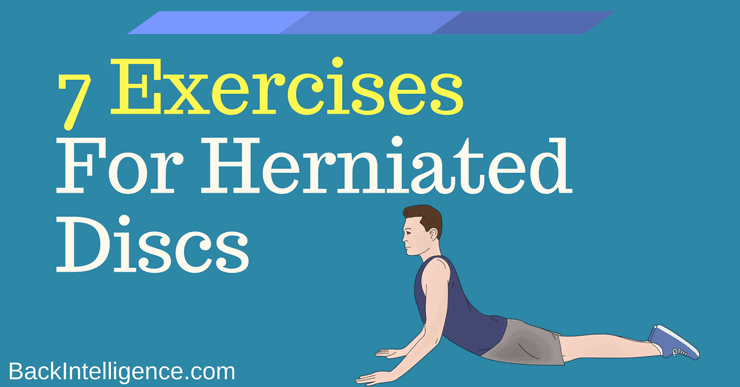
It is estimated that up to 80% of individuals will suffer from an episode of low back pain during their lifetime and Lumbar disc herniations are one of the common underlying issues.[1]
In this articles we will dive into specific herniated disc exercises that you can do at home (at the bottom).
Disc herniation most commonly occurs in the lower back (lumbar spine) and involves the displacement of disc material beyond the inter-vertebral disc space.[2]
In the most simple terms, the spine is made up of individual vertebrae stacked on top of each other. Between each vertebrae is an intervertebral disc that provides a cushion so the vertebrae don't rub together.
Furthermore, these discs (intervertebral discs) between the vertebrae, have a gel-like material inside (called a nucleus pulposus). A herniated disc is when that gel-like material ruptures through the outer layer of disc, and can press on the spinal cord or spinal nerves, resulting in symptoms, including disabling back pain and other associated symptoms that can make everyday activities difficult to perform.[2]
This illustration may help:
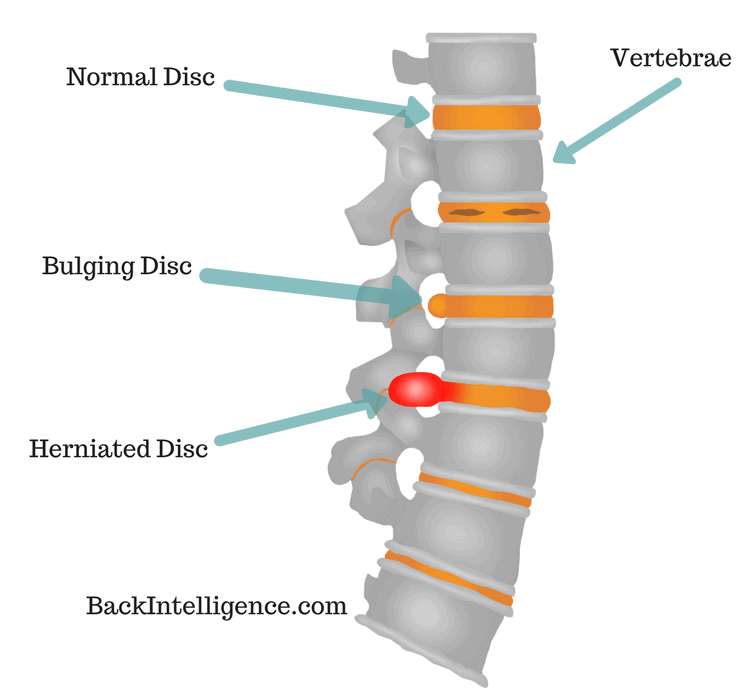
Note: A herniated disc is usually worse than a bulged disc.
Before we get to 7 herniated disc exercises, let's talk a little about the symptoms and treatment options of lumbar disc herniation…
Symptoms of herniated lumbar disc:
– Lower back pain (typically the first symptom)
– Leg pain (traveling up and down)[1][5]
– Leg numbness or tingling (traveling pain)[5]
– Leg weakness[1]
– Pain is worse from sitting[5]
– Restricted trunk flexion[1]
– Sciatica pain (Pinched Nerve)
Please note, a herniated disc DOESN'T always cause pain, so you must get a proper diagnosis.[2][5]
IMPORTANT: An extremely rare symptom of lumbar disc herniation is the loss of bowel or bladder control, which may signal that a more serious problem is lurking – cauda equina syndrome. This syndrome results from compression of the spinal nerve roots and is considered a medical emergency that requires immediate attention.[5]
What does a herniated disc feel like?
Lower back pain is typically the first symptom of a lumbar disc herniation. Often this pain will last for a few days and then subside, but leg pain, numbness or tingling, and/or weakness of the lower extremity often follows.
Typically the leg pain eventually travels below the knee and can even affect the ankle and foot.
How long does the pain last?
Most patients with a lumbar disc herniation will improve gradually over a period of days to weeks, with most patients being symptom free within 3 to 4 months.
Exercise works….
Patients that actively participate in an exercise program often report a significant reduction of pain and improved ability to perform their activities of daily living.[4][5]
7 Herniated Disc Exercises For Lower Back
Please do them gently!
Treatment Methodology:
According to this Clinical Evaluation and Treatment Options for Herniated Lumbar Disc "The McKenzie exercise program is believed to be one of the most beneficial. This program is individualized to the patient's symptoms and emphasizes exercises that minimize or centralize radiating pain."[5]
In addition, core stability exercises have been shown to reduce low back pain.[3][4]
Therefore, we have included many "Extension" type exercises from the Mckenzie method, as well as Core stability exercises. If any of these exercises cause more pain, please stop and see your physician.
1. Spinal Decompression

How it helps – Spinal decompression should be the very first thing you do to treat a herniated or bulging disc because it essentially creates space between your vertebrae, and thus takes pressure off the discs.
How to do it
– Use a bar or the top of a door (or anything you can hang from) and allow your body to "just hang".
– Hang for 30 seconds and do 3 sets.
– Release very slowly from this so as not to cause any spasms.
** This should not cause any pain. If you feel pain during it is not a good one for you. In that case, stop and try some of the other exercises below instead.
2. Standing Extension
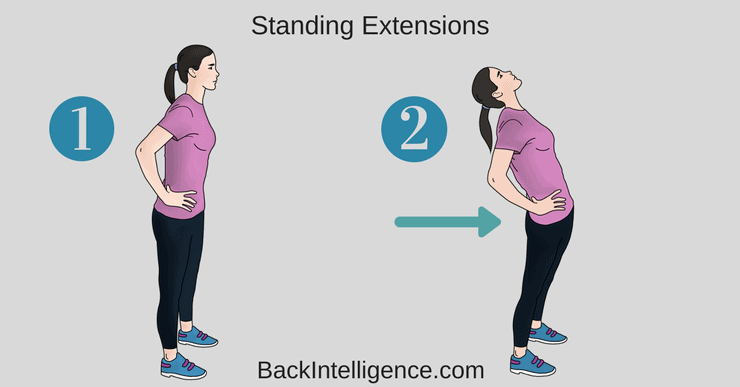
How it helps – This standing extension helps reverse what you do on a daily basis (hunching)… Since most bulging discs and herniated discs are caused by poor posture and repeated flexion of the spine (esp bending fwd in bad posture), this stretch helps push the disc back to neutral position.
How to do it
– Begin this exercise by standing up with good posture. Now take both hands and place them on both sides of your lower back. Now with the help of your hands push your pelvis forward and extend your spine back. Follow the extension with your neck so that you end up facing the ceiling.
– Start with 10 repetitions and do 2-3 sets.
– This one is particularly great to do when you need a break from sitting at your desk.
** This should not cause any pain. If you feel pain during it is not a good one for you. In that case, stop and try some of the other exercises below instead.
3. Half Cobra Pose (Prone Lumbar Extension)
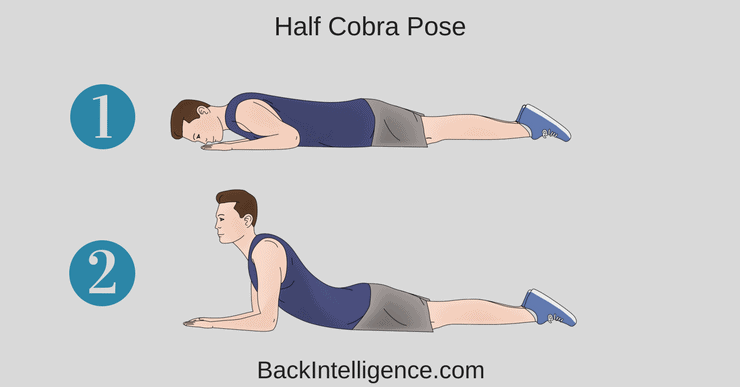
How it helps – The Half Cobra Stretch helps to push the disc material back towards the center of the inter-vertebral disc to allow for improved healing. The goal of repeated lower back extension is the "centralization of symptoms", which basically means pain that travels down the affected leg to the foot should come back up closer to the low back – which will in turn alleviate the pain.
How to do it
– Begin this exercise by lying on your stomach (prone position) and slowly prop yourself up on your elbows while keeping your hips in contact with the floor.
– Hold the prop-up position for 10-15 seconds before returning to the prone position (lying face down).
– Gradually increase to holding the end position for 30 seconds. Aim for 10 repetitions of this stretch.
** Initially, you may not be able to tolerate this position very well, so make sure you start slowly and carefully. If there's any pain, try a different exercise instead.
4. Full Cobra Pose (Advanced Extension)
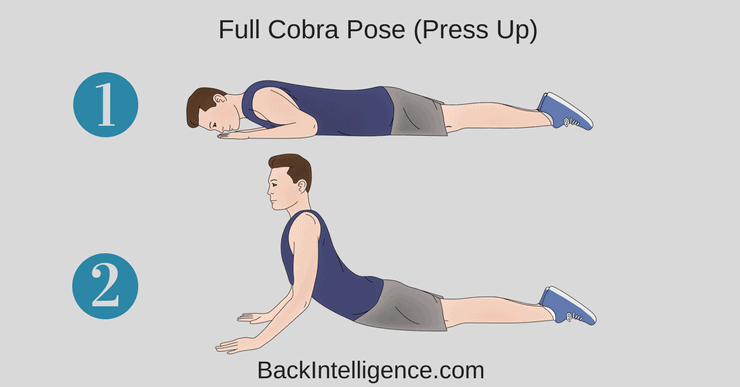
How it helps – This stretch is based on the same principle as the half Cobra pose above. This advanced extension helps to push disc material back towards the center of the intervertebral disc, with the goal of alleviating pain symptoms.
How to do it
– Once you've mastered the half cobra pose, you can increase the difficulty by moving to the advanced version of this stretch. Begin this exercise by lying on your stomach in the prone position (lying facing down) and slowly press up on your hands while keeping your pelvis in contact with the floor and lower back relaxed.
– Hold the prop-up position for 10 seconds. Aim for 10 repetitions of this stretch.
– Eventually try to hold this pose for longer if it feels good (20-30 seconds).
** If you feel pain during this exercise, it is not a good one for you. In that case, stop and try some of the other exercises instead.
5. Cat-Cow

How it helps – This is one of the most popular herniated disc exercises. By combining two yoga poses, the cat-cow stretch can help to relieve pressure on the herniated disc by opening the intervertebral disc space. It also improves mobility of the spine, which may help to relieve disc herniation pain and speed recovery.
How to do it
– Begin this stretch on your hands and knees. Inhale and let your stomach "drop" towards the floor as you look up towards the ceiling.
– Follow this by exhaling and slowly rounding your spine while pressing into the floor with your hands and slightly curving your neck to look at your feet.
– Aim for 10 repetitions of this stretch and do 2-3 sets.
Related: Watch the Cat-Cow Stretch Video
Exercises 6 and 7 are meant to help stabilize and align your spine so that you don't get herniated discs in the future.….
6. Bird Dog
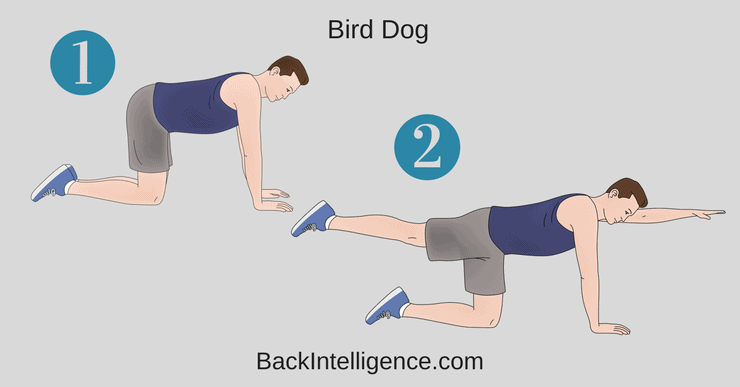
How it helps – This exercise will help strengthen and stabilize your lower back and deep spine muscles. This will help you to maintain a good posture and avoid future episodes of herniated discs.
How to do it:
– Begin on your hands and knees with your hands positioned under your shoulders and knees positioned under your hips.
– Raise your left arm and reach it forwards until it is aligned with your torso; at the same time, kick your right leg backwards until is it aligned with your torso.
– Hold this position for 2-3 seconds before slowly returning to the starting position.
– Repeat with your right arm and left leg.
– Alternate sides for 10 repetitions and do 2-3 sets.
** Ensure that your head, neck, and back maintain a neutral alignment to minimize stress on your neck.
7. Plank
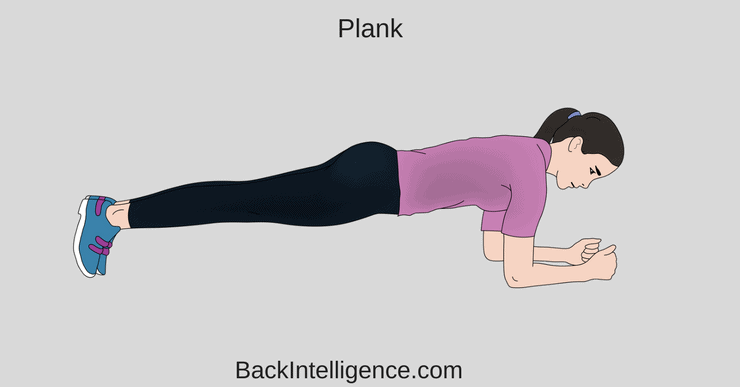
How it helps – Just like the bird dog, this "Core" exercise will help bring your pelvis into right position by strengthening the deep spinal muscles and glutes (butt muscles).
How to do it
– Begin lying on your stomach with your forearms against the mat.
– Engage your core and lift your body so that you are resting on your forearms and toes.
– Start with 10 second holds and work up to 30 second holds, do 2-3 sets.
** Ensure to keep your back straight throughout the entire exercise – spine in neutral position.
While you may be tempted to spend your days in bed or on the couch for fear of aggravating your disc herniation pain, you shouldn't! Performing these herniated disc stretches and exercises allows you to take a proactive approach towards your recovery and may help to reduce your symptoms and increase the overall health of your back.
Check out this video about Herniated discs from our Chiropractor, Dr. Oliver:
Other herniated disk treatment options include:
Rest – often a couple of days of rest will help to calm severe pain caused by lumbar disc herniation. However, it's important that you don't rest for longer than this as it can actually worsen pain and stiffness.
Anti-inflammatory medications – medications such as ibuprofen and naproxen may help to reduce inflammation and relieve pain.
Physical therapy – performing specific exercises to increase range of motion and strengthen muscles in your lower back and core may help to relieve pain and reduce your chance of re-injuring yourself.
Spinal manipulation – manipulation of the joints of the lower back may help to improve range of motion and decrease pain.
Massage therapy – may help to increase blood circulation and relax muscles thereby helping to reduce pain.
Epidural steroid injections – injection of corticosteroids into the affected area may help to reduce local inflammation and relieve pain.
Did you find it useful? Share it with a friend!
Recommended Program:
The Complete Posture Fix (With Dr. Oliver) – Fix your fwd head and rounded shoulders posture, ergonomics, get out of pain and increase your mobility.
Learn More
Related Articles:
Bulging Disc Treatment
Spondylolisthesis Exercises
How to fix rounded shoulders
What are myofascial trigger points and how to release them
Cervical Herniated Disc Exercises
How Can Poor Posture Result In Back Pain
How To Sleep With Lower Back Pain – The Dos And Don's
Sources:
[1] Amin R, Andrade N, Neuman B. Lumbar Disc Herniation. Curr Rev Musculoskelet Med. 2017;10(4):507-516. doi:10.1007/s12178-017-9441-4
[2] Schoenfeld AJ, Weiner B. Treatment of lumbar disc herniation: Evidence-based practice. Int J Gen Med. 2010:209. doi:10.2147/ijgm.s12270
[3] Yazdani A, Hesari P, Eghbali Khosro S, Anbarian M, Babaei-Ghazani A. Effects of six-week exercise training protocol on pain relief in patients with lumbar disc herniation. Journal of Analytical Research in Clinical Medicine. 2016;4(1):27-33. doi:10.15171/jarcm.2016.005

Licensed chiropractor, DC (Owner of Forme Clinic, Stoney Creek, ON, L8G 1B9)
Dr. Shaina McQuilkie graduated from Brock University in 2004 with a Bachelor of Kinesiology (Honours). She then attended D'Youville College, in Buffalo, New York and obtained her Doctorate of Chiropractic Degree in 2008. After graduating, Dr. McQuilkie practiced in a multi-disciplinary healthcare facility based in Hamilton, Ontario gaining experience treating a variety of musculoskeletal injuries.
Co Authors :

Corrective Exercise Specialist (NASM-CES), Certified Personal Trainer (NASM-CPT), Professional Dancer
As a long time back sufferer Leon found unique methods to alleviate his pain using natural methods including self massage, exercise/stretching and postural habits. He founded Backintelligence.com to empower others to fix their postures and ease their back pain from home.
Set your Author Custom HTML Tab Content on your Profile page
Hip and Lower Back Pain 33 Weeks Pregnant
Source: https://backintelligence.com/herniated-disc-exercises/
0 Response to "Hip and Lower Back Pain 33 Weeks Pregnant"
ارسال یک نظر